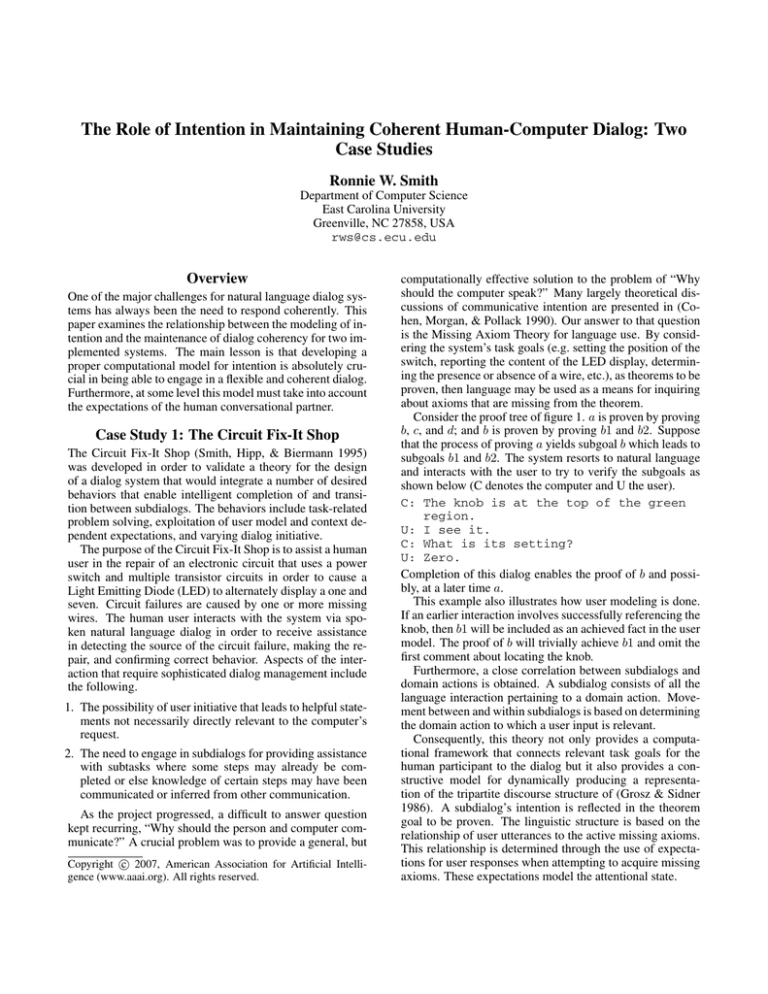
The Role of Intention in Maintaining Coherent Human-Computer Dialog: Two
Case Studies
Ronnie W. Smith
Department of Computer Science
East Carolina University
Greenville, NC 27858, USA
rws@cs.ecu.edu
Overview
One of the major challenges for natural language dialog systems has always been the need to respond coherently. This
paper examines the relationship between the modeling of intention and the maintenance of dialog coherency for two implemented systems. The main lesson is that developing a
proper computational model for intention is absolutely crucial in being able to engage in a flexible and coherent dialog.
Furthermore, at some level this model must take into account
the expectations of the human conversational partner.
Case Study 1: The Circuit Fix-It Shop
The Circuit Fix-It Shop (Smith, Hipp, & Biermann 1995)
was developed in order to validate a theory for the design
of a dialog system that would integrate a number of desired
behaviors that enable intelligent completion of and transition between subdialogs. The behaviors include task-related
problem solving, exploitation of user model and context dependent expectations, and varying dialog initiative.
The purpose of the Circuit Fix-It Shop is to assist a human
user in the repair of an electronic circuit that uses a power
switch and multiple transistor circuits in order to cause a
Light Emitting Diode (LED) to alternately display a one and
seven. Circuit failures are caused by one or more missing
wires. The human user interacts with the system via spoken natural language dialog in order to receive assistance
in detecting the source of the circuit failure, making the repair, and confirming correct behavior. Aspects of the interaction that require sophisticated dialog management include
the following.
1. The possibility of user initiative that leads to helpful statements not necessarily directly relevant to the computer’s
request.
2. The need to engage in subdialogs for providing assistance
with subtasks where some steps may already be completed or else knowledge of certain steps may have been
communicated or inferred from other communication.
As the project progressed, a difficult to answer question
kept recurring, “Why should the person and computer communicate?” A crucial problem was to provide a general, but
c 2007, American Association for Artificial IntelliCopyright gence (www.aaai.org). All rights reserved.
computationally effective solution to the problem of “Why
should the computer speak?” Many largely theoretical discussions of communicative intention are presented in (Cohen, Morgan, & Pollack 1990). Our answer to that question
is the Missing Axiom Theory for language use. By considering the system’s task goals (e.g. setting the position of the
switch, reporting the content of the LED display, determining the presence or absence of a wire, etc.), as theorems to be
proven, then language may be used as a means for inquiring
about axioms that are missing from the theorem.
Consider the proof tree of figure 1. a is proven by proving
b, c, and d; and b is proven by proving b1 and b2. Suppose
that the process of proving a yields subgoal b which leads to
subgoals b1 and b2. The system resorts to natural language
and interacts with the user to try to verify the subgoals as
shown below (C denotes the computer and U the user).
C: The knob is at the top of the green
region.
U: I see it.
C: What is its setting?
U: Zero.
Completion of this dialog enables the proof of b and possibly, at a later time a.
This example also illustrates how user modeling is done.
If an earlier interaction involves successfully referencing the
knob, then b1 will be included as an achieved fact in the user
model. The proof of b will trivially achieve b1 and omit the
first comment about locating the knob.
Furthermore, a close correlation between subdialogs and
domain actions is obtained. A subdialog consists of all the
language interaction pertaining to a domain action. Movement between and within subdialogs is based on determining
the domain action to which a user input is relevant.
Consequently, this theory not only provides a computational framework that connects relevant task goals for the
human participant to the dialog but it also provides a constructive model for dynamically producing a representation of the tripartite discourse structure of (Grosz & Sidner
1986). A subdialog’s intention is reflected in the theorem
goal to be proven. The linguistic structure is based on the
relationship of user utterances to the active missing axioms.
This relationship is determined through the use of expectations for user responses when attempting to acquire missing
axioms. These expectations model the attentional state.
a: circuit behavior
aa
E
aa
E
aa
E
a
b: knob setting
c: switch setting
d: LED display
% J
%
J
%
J
(b1: knob id) (b2: knob value)
Figure 1: Sample theorem description
The development of the Circuit Fix-It Shop illustrates a
case where the choice of the intentional model—acquiring
missing axioms for completion proofs of task goals—led
naturally to a coherent dialog interaction. The next case
study illustrates a situation where there was one failed attempt because expectations of the conversational partner
were not properly taken into account initially.
Case Study 2: The Command Post of the
Future Story Capture System
The Command Post of the Future (CPOF) story capture system (Smith et al. 2002)1 is a multimodal spoken natural language dialog system that was developed in order to provide
a means for capturing a commander’s expectations about
planned military actions. If we think about these expectations as a story (Gershon & Page 2001), a possible machine
representation for these expectations is a story graph, where
the nodes of the graph represent expectations at particular
moments in time and the arcs represent change of expectations between nodes. An example set of expectations in a
node might be the following.
1. Delta company assumes an attack by
fire position in building B.
2. Alpha company assumes an attack by
fire position on hill C.
3. Echo company assumes an observation
position on hilltop D.
Dialog context is used for handling issues concerning military echelons, multiple databases, dynamic name creation,
and relative time references. A first attempt at developing the dialog model for this system focused on a communicative intention of determining the information for a story
node. This was unsuccessful because the conversational participant, the commander, has no conception of a story node.
What a commander does have as a working model as they
plan is the notion of an activity. Various types of activities in which a military force can be engaged include movement, position establishment, and reconnaissance. Associated with an activity type are parameters, some of which
are mandatory and some are optional. The dialog system
1
Support for this system was originally provided by DARPA.
Work has continued on this system as it serves as an interesting
testbed for ideas.
will attempt to continue interaction about the current activity until values for all mandatory parameters are supplied.
This approach is another instantiation of the Missing Axiom
Theory of dialog. Modeling of the interaction of the dialog
based on activities enables coherent interactions to occur.
Ongoing work is focusing on extending the dialog model to
allow for interaction about higher level strategic commander
intent (Rogers 2003) (Adams 2006).
Conclusion
This paper has briefly examined the role of modeling intention for enabling an intelligent system to engage in coherent
human-computer dialog. What we have observed is that it
is essential to have a correct model of intention that takes
the expectations of the human conversational partner into
account.
References
Adams, B. 2006. Activity based multimodal plan recognition of commander intent. Master’s thesis, East Carolina
University.
Cohen, P. R.; Morgan, J.; and Pollack, M., eds. 1990. Intentions in Communication. Cambridge, Mass.: MIT Press.
Gershon, N., and Page, W. 2001. What storytelling can do
for information visualization. Communications of the ACM
31–37.
Grosz, B., and Sidner, C. 1986. Attentions, intentions,
and the structure of discourse. Computational Linguistics
12(3):175–204.
Rogers, J. C. 2003. Developing bayesian networks for
recognition of commander intent. Master’s thesis, East
Carolina University.
Smith, R.; Manning, B.; Rogers, J.; Adams, B.; Abdul, M.;
and Alvarez, A. 2002. A dialog architecture for military
story capture. In Proceedings of the 3rd SIGdial Workshop
on Discourse and Dialogue, 184–187.
Smith, R.; Hipp, D.; and Biermann, A. 1995. An architecture for voice dialog systems based on Prolog-style
theorem-proving. Computational Linguistics 21:281–320.





